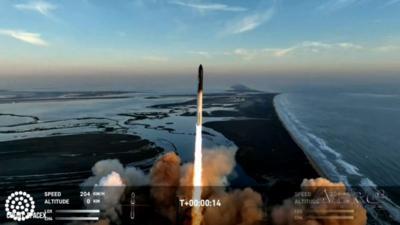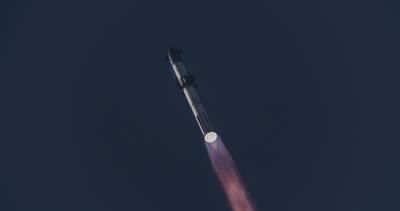Sat, Nov 25, 2023
November 18th Test Launch Is Producing Immense Amounts of Data
SpaceX is releasing a few tentative details about the recent IFT2 Starship test... continually emphasizing to all those who can't see the successes for the perceived failures, that this was, indeed, a test.

Among the many bullet points, SpaceX is noting the following:
On November 18, 2023, Starship successfully lifted off at 7:02 a.m. CT from Starbase in Texas and achieved a number of major milestones...
- All 33 Raptor engines on the Super Heavy Booster started up successfully and, for the first time, completed a full-duration burn during ascent.
- Starship executed a successful hot-stage separation, powering down all but three of Super Heavy’s Raptor engines and successfully igniting the six second stage Raptor engines before separating the vehicles. This was the first time this technique has been done successfully with a vehicle of this size.
- Following separation, the Super Heavy booster successfully completed its flip maneuver and initiated the boostback burn before it experienced a rapid unscheduled disassembly. The vehicle breakup occurred more than three and a half minutes into the flight at an altitude of ~90 km over the Gulf of Mexico.
- Starship's six second stage Raptor engines all started successfully and powered the vehicle to an altitude of ~150 km and a velocity of ~24,000 km/h, becoming the first Starship to reach outer space and nearly completing its full-duration burn.
- The flight test’s conclusion came when telemetry was lost near the end of second stage burn prior to engine cutoff after more than eight minutes of flight. The team verified a safe command destruct was appropriately triggered based on available vehicle performance data.
-

- The water-cooled flame deflector and other pad upgrades performed as expected, requiring minimal post-launch work to be ready for upcoming vehicle tests and the next integrated flight test.
SpaceX adds that, "With a test like this, success comes from what we learn, and this flight test will help us improve Starship’s reliability as SpaceX seeks to make life multiplanetary. Data review is ongoing as we look for improvements to make for the next flight. The team at Starbase is already working final preparations on the vehicles slated for use in Starship’s third flight test, with Ship and Booster static fires coming up next."
More News
He Attempted To Restart The Engine Three Times. On The Third Restart Attempt, He Noticed That Flames Were Coming Out From The Right Wing Near The Fuel Cap Analysis: The pilot repor>[...]
Make Sure You NEVER Miss A New Story From Aero-News Network Do you ever feel like you never see posts from a certain person or page on Facebook or Instagram? Here’s how you c>[...]
From 2009 (YouTube Edition): Leading Air Show Performers Give Their Best Advice for Newcomers On December 6th through December 9th, the Paris Las Vegas Hotel hosted over 1,500 air >[...]
Aero Linx: NASA ASRS ASRS captures confidential reports, analyzes the resulting aviation safety data, and disseminates vital information to the aviation community. The ASRS is an i>[...]
“For our inaugural Pylon Racing Seminar in Roswell, we were thrilled to certify 60 pilots across our six closed-course pylon race classes. Not only did this year’s PRS >[...]
 NTSB Final Report: Rutan Long-EZ
NTSB Final Report: Rutan Long-EZ ANN FAQ: Turn On Post Notifications
ANN FAQ: Turn On Post Notifications Classic Aero-TV: ICAS Perspectives - Advice for New Air Show Performers
Classic Aero-TV: ICAS Perspectives - Advice for New Air Show Performers ANN's Daily Aero-Linx (06.28.25)
ANN's Daily Aero-Linx (06.28.25) Aero-News: Quote of the Day (06.28.25)
Aero-News: Quote of the Day (06.28.25)




